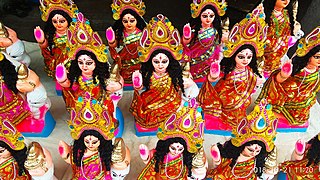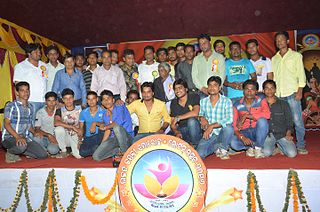
Bihu is of three types and it is an important cultural festival unique to the Indian state of Assam – 'Rongali' or 'Bohag Bihu' observed in April, 'Kongali' or 'Kati Bihu' observed in October or November, and 'Bhogali' or 'Magh Bihu' observed in January. The festivals present an admixture of Tibeto-Barman, Austroasiatic and Indo-Aryan traditions entwined so intricately that it is impossible to separate them—festivals which are uniquely Assamese to which all communities of Assam had contributed elements. The Rongali Bihu is the most important of the three, celebrating spring festival. The Bhogali Bihu or the Magh Bihu is a harvest festival, with community feasts. The Kongali Bihu or the Kati Bihu is the sombre, thrifty one reflecting a season of short supplies and is an animistic festival.

Makar(a) Sankranti, also referred to as Uttarayana, Makar, or simply Sankranti, is a Hindu observance and a festival. Usually falling on the date of 14 January annually, this occasion marks the transition of the sun from the zodiac of Sagittarius (dhanu) to Capricorn (makara). Since the sun has made this transition which vaguely coincides with moving from south to north, the festival is dedicated to the solar deity, Surya, and is observed to mark a new beginning. Many native multi-day festivals are organised on this occasion all over India.
Guru Purnima is a religious festival dedicated to offering respect to all the spiritual and academic gurus. It is celebrated as a festival in India, Nepal and Bhutan by Hindus, Jains and Buddhists. This festival is traditionally observed to honour one's chosen spiritual teachers or leaders. It is observed on the full moon day (Purnima) in the month of Ashadha (June–July) according to the Hindu Calendar. The festival was revived by Mahatma Gandhi to pay tribute to his spiritual guru, Shrimad Rajchandra. It is also known as Vyasa Purnima, for it marks the birthday of Veda Vyasa, the sage who authored the Mahabharata and compiled the Vedas.

Śrāvaṇa is the fifth month of the Hindu calendar. In India's national civil calendar, Śrāvaṇa is the fifth month of the year, beginning on July 23 and ending on August 22. In the Tamil calendar, it is known as Āvani and is the fifth month of the solar year. In lunar religious calendars, Śrāvaṇa begins on the new moon or the full moon and is the fifth month of the year. Srabon is the fourth month of the solar Bengali calendar. It is also the fourth month of the Nepali calendar. Śrāvaṇa is also the second month of Varsha.
Bargarh is an emerging city and municipality in Bargarh district in the state of odisha in India. It is the administrative headquarters of Bargarh District. Bargarh is popularly known for intensive cultivation of 'paddy', therefore called "Bhata Handi" of Odisha.

Hanuman Jayanti is a Hindu festival celebrating the birth of the Hindu deity, and one of the protagonists of the Ramayana, Hanuman. The celebration of Hanuman Jayanti varies by time and tradition in each state of India. In most northern states of India, the festival is observed on the full-moon day of the Hindu month of Chaitra. In Karnataka, Hanuman Jayanti is observed on Shukla Paksha Trayodashi, during the Margashirsha month or in Vaishakha, while in a few states like Kerala and Tamil Nadu, it is celebrated during the month of Dhanu. Hanuman Jayanti is observed on Pana Sankranti in the eastern state of Odisha, which coincides with the Odia New Year.

Sharad Purnima is a religious festival celebrated on the full moon day of the Hindu lunar month of Ashvin, marking the end of the monsoon season. The full moon night is celebrated in different ways in various cultural regions across Indian subcontinent.
This article lists the traditional festivals and other cultural events in the Odisha region of India. Odisha celebrates 13 festivals in 12 months as the saying goes Bāra Māsare Tera Parba.

Kartika Purnima is a Hindu, Sikhism and Jain cultural festival that is celebrated on Purnima. It falls in November or December of the Gregorian calendar and is also known as Tripurari Purnima or Deva-Deepavali, the gods' festival of lights. Karthika Deepam is a related festival that is celebrated in South India and Sri Lanka on a different date. It follows Diwali by about 15 days.

Nuakhai is an agricultural festival mainly observed by people of Western Odisha in India. Nuakhai is observed to welcome the new rice of the season. According to the calendar it is observed on panchami tithi of the lunar fortnight of the month of Bhadrapada or Bhadraba (August–September), the day after the Ganesh Chaturthi festival. This is the most important social festival of Western Odisha and adjoining areas of Simdega in Jharkhand, where the culture of Western Odisha is much predominant.

‘Olash’ is a coastal village in Jagatsinghpur district of Odisha, India. It is a village having a population of about 1000 people, and is located about 30 km from the district town of Jagatsinghpur on the Cuttack–Naharana road, about 5 km from the Bay of Bengal to the east. The village is known for paddy and Chilly cultivation and "Lotus club"- A premier social organization.

Baladevjew Temple is situated in Ichhapur, Kendrapara, Odisha, India. Baladevjew Temple is a very famous temple of Odisha and Balarama is its main divinity. However, Jagannath and Subhadra are also worshipped in the Ratna Sinhasan in the main temple. An idol representing tulasi as a goddess in a seated position is also present after the sacred seven steps.
Festivals of Kalahandi are rich in nature as the place is a melting point of South Odisha and Western Odisha. Kalahandi, a district of Odisha, shelters a substantial tribal population residing both in hills and plain land. It is a place where people of different cultures, traditions, languages and beliefs live together.
Sambalpur, in Orissa, India, is a region that has a distinct cultural identity. The songs, clothing, dances, language and festivals celebrated in Sambalpur are unique. This distinct cultural identity arises from the strong association of the tribal and folk communities which have been coexisting in Sambalpur for centuries.
Here is a list of glossary of Culture of India in alphabetical order:
Bangomunda is a tehsil in the Balangir district of Odisha, India with historical importance. It is located 72 km from the district capital in the city of Balangir. Bangomunda was formerly known as Banganmura which means Brinjal Firm.
Sisua is a medium-sized village in the Salipur taluk/mandal/tehsil/block of Cuttack district in the state of Odisha, India, close to the new Sisua Village Jagannath Temple. The village lies South of Cuttack to Kendraparda road left of Sisua village road if traveling South. As of 2009 Kantapara is the gram panchayat of Sisua village
Lahanda is a village in Odisha, India. It is located in the Attabira block of Bargarh district.

National Paddy Day is an annual festival in Nepal which marks the beginning of the rice planting season. It is celebrated on the 15th of Ashadh every year. The festival is also named Ropain Diwas, Dhan Diwas, and Ashadh Pandra.










